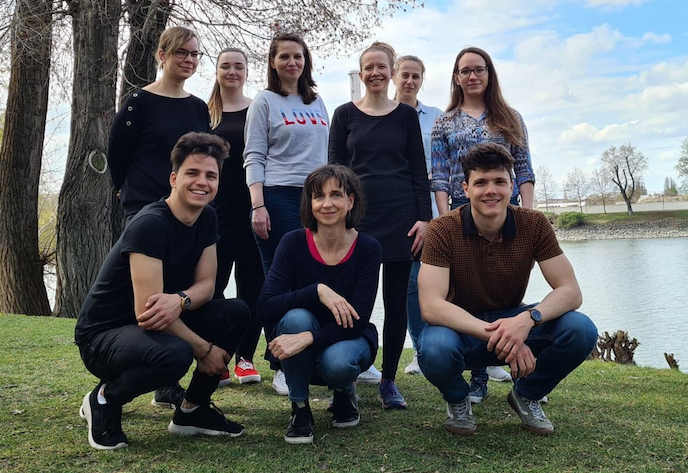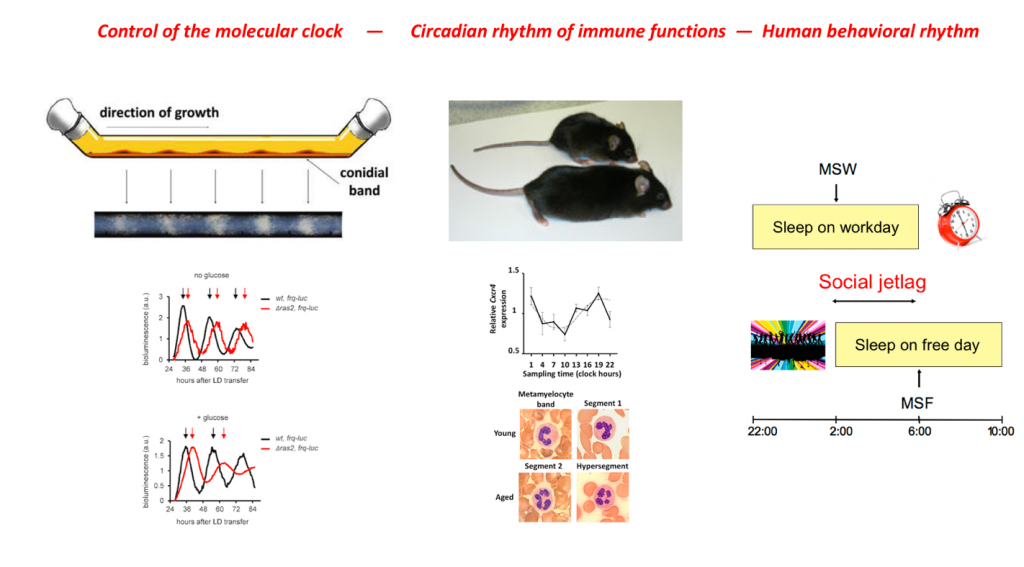Lab members:
Dr. Krisztina Káldi (PI)
Dr. Krisztina Ella
Ágnes Sűdy
Anita Szőke
Orsolya Sárkány
Zsófia Búr
The circadian time-keeping system enhances the adaptive ability of the organism by preparing it to the periodical changes in the environment, and on the other hand, allows temporal separation of otherwise conflicting biochemical activities (e.g. catabolic and anabolic processes). Endogenous time measuring is organized at the cellular level and almost all mammalian cells harbour self-sustained circadian oscillators. Coherent time-measuring at the level of the whole organism needs synchronization of these cellular oscillators. The suprachiasmatic nucleus is considered as the master pacemaker, that drives peripheral oscillators by neuronal and humoral mechanisms.
Circadian rhythm disturbances are associated with an increased risk of severe health problems, including cardiovascular diseases, metabolic syndrome, diabetes mellitus, various malignancies and psychiatric diseases such as mood disorders. In the modern society the risk for circadian misalignment is increasing due to the growing demand of shift work and intense exposure to artificial light during the late evening hours. Moreover, a large portion of the society is affected by social jetlag, the disruption of the circadian rhythm by sleeping at different times on workdays and during the weekend.
Our research group is interested in a broad field of chronobiology research including the examination of molecular clock functions, studying circadian control of the immune system and exploring human behavioural rhythms.
Publications
Sűdy ÁR, Ella K, Bódizs R and Káldi K
Association of Social Jetlag With Sleep Quality and Autonomic Cardiac Control During Sleep in Young Healthy Men
Front. Neurosci. 13:950, 2019
Ella K, Mócsai A, Káldi K
Circadian regulation of neutrophils: Control by a cell-autonomous clock or systemic factors?
Eur J Clin Invest. 2018;e12965.
Gyöngyösi N, Szöke A, Ella K, Káldi K
The small G protein RAS2 is involved in the metabolic compensation of the circadian clock in the circadian model Neurospora crassa
Biol. Chem. 292:14929-14939, 2017
Ella K , Csépányi-Kömi R , Káldi K
Circadian regulation of human peripheral neutrophils
BRAIN BEHAVIOR AND IMMUNITY 57:209-221, 2016
Gyöngyösi N, Káldi K
Interconnections of Reactive Oxygen Species Homeostasis and Circadian Rhythm in Neurospora crassa
ANTIOXIDANTS AND REDOX SIGNALING 20: 3007-3023, 2014
Haraszti RÁ, Ella K, Gyöngyösi N, Roenneberg T, Káldi K
Social jetlag negatively correlates with academic performance in undergraduates
Chronobiol Int 31:603-12, 2014
Gyöngyösi N, Nagy D, Makara K, Ella K, Káldi K
Reactive oxygen species can modulate circadian phase and period in Neurospora crassa
FREE RADICAL BIOLOGY AND MEDICINE 58: pp. 134-143, 2013
Ruisanchez E, Cselenyak A, Papp RS, Nemeth T, Káldi K, Sandor P, Benyo Z
Perivascular expression and potent vasoconstrictor effect of dynorphin a in cerebral arteries
PLOS ONE 7:(5) p. e37798, 2012
* Malzahn E, * Ciprianidis S, * Káldi K (*joint first authors), Schafmeier T, Brunner M
Photoadaptation in Neurospora by Competitive Interaction of Activating and Inhibitory LOV Domains
CELL 142:(5) pp. 762-772., 2010
Brunner M, Káldi K
Interlocked feedback loops of the circadian clock of Neurospora crassa
MOLECULAR MICROBIOLOGY 68:(2) pp. 255-262., 2008
Kozma-Bognar L, Káldi K
Synchronization of the Fungal and the Plant Circadian Clock by Light
CHEMBIOCHEM 9:(16) pp. 2565-2573., 2008
Káldi K, Gonzalez BH, Brunner M
Transcriptional regulation of the Neurospora circadian clock gene wc-1 affects the phase of circadian output
EMBO Rep 7: 199-204, 2006
Schafmeier T, Káldi K, Diernfellner A, Mohr C and Brunner M
Phosphorylation dependent maturation of Neurospora circadian clock protein from a nuclear repressor towards a cytoplasmic activator
Genes Dev. 20: 297-306, 2006
Sirokmany G, Szidonya L, Káldi K, Gaborik Z, Ligeti E, Geiszt M
Sec14 Homology Domain Targets p50RhoGAP to Endosomes and Provides a Link between Rab and Rho GTPases
Biol. Chem. 281: 6096-6105, 2006
*Schafmeier T, *Haase A, *Káldi K (*joint first authors), Scholz J, Fuchs M, Brunner M
Transcriptional feedback of Neurospora circadian clock gene by phosphorylation-dependent inactivation of its transcription factor
Cell 122: 235-246, 2005
Rada B K, Geiszt M, Kaldi K, Timar C, Ligeti E
Dual role of phagocytic NADPH oxidase in bacterial killing
Blood 104: 2947-2953, 2004
Horváth B, Hrabák A, Káldi K, Sándor P and Benyó Z
Contribution of the heme oxigenase pathway to the maintenance of the hypothalamic blood flow during diminished NO synthesis
Cereb. Blood Flow Metab. 23: 653-657, 2003
Káldi K, Kalocsai A, Rada BK, Mezo G, Molnar GZ, Bathori G, Ligeti E
Degranulation and superoxide production depend on cholesterol in PLB-985 cells, Biochem. Biophys.
Res. Commun. 310:1241-1246, 2003
Lacza, L. Dézsi, K. Káldi, E.M. Horváth, P. Sándor and Z. Benyó
Prostacyclin-mediated compensatory mechanism in the coronary circulation during acute NO synthase blockade
Life Sci 73: 1141-1149, 2003
Káldi K, Szeberenyi J, Rada BK, Kovacs P, Geiszt M, Mocsai A, Ligeti E
Contribution of phopholipase D and a brefeldin A sensitive ARF to chemoattractant induced superoxide production and secretion of human neutrophils
Leuk. Biol. 71: 695-700, 2002
Lacza, K. Káldi, K. Kövecs, C. Görlach, Z. Nagy, P. Sándor, Z. Benyó and M. Wahl
Involvement of prostanoid release in the mediation of UTP-induced cerebrovascular contraction in the rat
Brain Res. 896: 169-174, 2001
*Donzeau M, *Káldi K (*joint first authors), Adam A, Paschen S, Wanner G, Guiard B, Bauer MF, Neupert W, Brunner M
The preprotein translocase component Tim23 links the inner and outer mitochondrial membranes
Cell 101: 401-412, 2000
Paschen SA, Rothbauer U, Káldi K, Bauer MF, Neupert W and Brunner M
The role of the TIM8-13 complex in the import of Tim23 into mitochondria
EMBO J. 19:6392-6400, 2000
Geiszt M, Szeberényi J, Káldi K and Ligeti E
Role of different Ca2+ sources in the superoxid e production of human neutrophil granulocytes
Free Rad Biol Med 26:1092-1099, 1999
Káldi K and Neupert W
Protein translocation into mitochondria
Biofactors 8: 221-224, 1998
Káldi K, Bauer MF, Sirrenberg C, Neupert W, Brunner M
Biogenesis of Tim23 and Tim17, integral components of the TIM machinery for matrix targeted preproteins
EMBO J. 17:1569-76, 1998
Káldi K, Szászi K, Koncz G, Suszták K and Ligeti E
Arachidonic acid activatable electrogenic H+ transport in the absence of cytochrome b558 in human T lymphocytes
FEBS Lett. 381:156-160, 1996
Suszták K, Káldi K, Kapus A and Ligeti E
Ligands of purinergic receptors stimulate electrogenic H+-transport of neutrophils
FEBS Lett. 375:79-82, 1995
Geiszt M, Káldi K, Szeberényi J and Ligeti E
Thapsigargin inhibits calcium entry into human neutrophil granulocytes
Biochem. J. 305:525-528, 1995
Káldi K, Szaszi K, Susztak K, Kapus A, Ligeti E
Lymphocytes posses an electrogenic H+ transporting pathway in their plasma membrane
Biochem. J. 301:329-334, 1994
Káldi K, Diestelkotter P, Stenbeck G, Auerbach S, Jakle U, Magert HJ, Wieland FT, Just WW
Membrane topology of the 22 kDa integral peroxisomal membrane protein
FEBS Lett. 315:217-222, 1993
Kapus, K. Szászi, K. Káldi, E. Ligeti and A. Fonyó
Is the mitochondrial Ca2+ uniporter a voltage-modulated transport pathway?
FEBS Lett. 282: 61-64, 1991
Kapus, K. Szászi, K. Káldi, E. Ligeti and A. Fonyó
Ruthenium red inhibits mitochondrial Na+ and K+ uniports induced by magnesium removal
Biol. Chem. 265: 18063-18066, 1990

